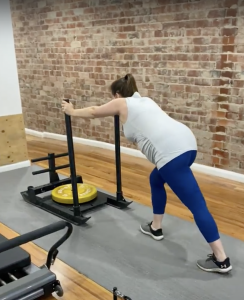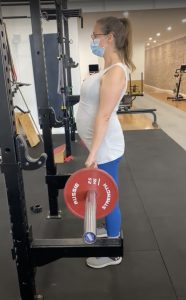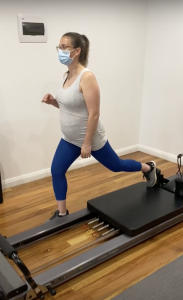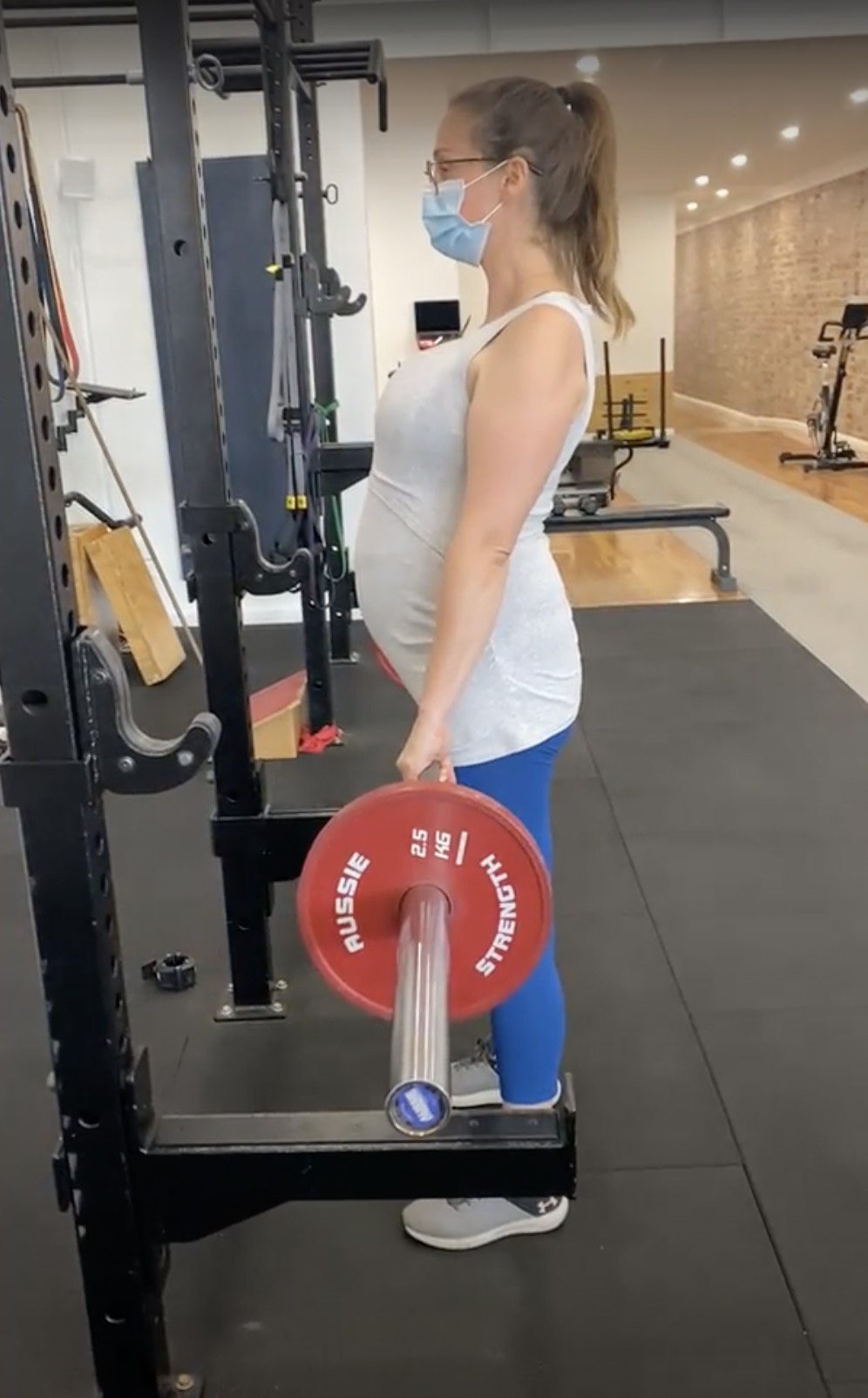Over the years there has been a lot of confusion on whether exercise is safe to complete and what the effects are for both the mother and the baby. The latest evidence based guidelines state that all pregnant women without contraindications should be physically active during pregnancy because there are so many known benefits for both mum and bub.
The evidence states that meeting the physical activity guidelines while pregnant leads to fewer newborn complications as well as many maternal health benefits decreasing the risk of pre-eclampsia, gestational hypertension and diabetes, excessive weight gain, instrumental delivery, urinary incontinence, depression, back and pelvic pain.

75kg sled push
Evidence has found that not only are there many benefits but that exercise is NOT associated with a higher risk of:
- Miscarriage
- Still birth
- Neonatal death
- Preterm birth
- Pre-labour membrane rupture
- Neonatal hypoglycemia
- Low birth weight
- Birth defects
Despite the evidence supporting exercise, the sad thing is that currently only 15% of pregnant women are currently meeting the recommended exercise guidelines.
What are the guidelines?
A minimum of 150 minutes of moderate intensity exercise each week to achieve clinically meaningful health benefits and reduction in pregnancy complications. Moderate intensity, is exercise that gets you breathless and feeling like you are working reasonably hard. This should consist of a variety of aerobic and resistance training activities to achieve greater benefits.
This can be accumulated over minimum 3 days a week, however being active every day (even in a small way) is encouraged.
What are the contraindications and justifiable reasons to not start strenuous exercise?
- Unexplained persistent bleeding
- Placenta Praevia >28 weeks
- Ruptured membranes
- Premature labour
- Incompetent cervix
- Intrauterine growth restriction
- Pre- eclampsia
- Having triplets or more
- Uncontrolled type 1 diabetes, high blood pressure, thyroid disease
- Serious cardiovascular, respiratory or systemic disorder
- Please note with these conditions it is still ok to continue normal activities of daily living.
If you have the following conditions it is recommended that you see your obstetrician or doctor before commencing strenuous activity in some cases it may still be safe to start an exercise program.
- Recurrent pregnancy loss
- Gestational hypertension
- History of spontaneous pre-term birth
- Mild – moderate cardiovascular disease or respiratory disease
- Symptomatic anaemia
- Malnutrition
- Eating disorder
- Twin pregnancy after the 28th week
- Other specific medical conditions
What exercise is best?
Below is a general guide for exercise during pregnancy. We would recommend an individualised plan for your specific situation prescribed by a clinical exercise professional like an Exercise Physiologist or Physiotherapist.
As stated previously the evidence highly recommends weight / strength based training and aerobic/cardio exercise. The length and intensity of the session depends on how much exercise you completed prior to pregnancy. Despite this, it is still better to start exercise in pregnancy rather than stay sedentary.
The type of exercises that should be completed are ones that focus on maintaining function, preventing the decline in capacity as well as preparing the body for childbirth. Areas to strengthen include the pelvic floor muscles, abdominals and posterior chain muscles (muscles that cover the back of your body) as well as upper body and lower body pushing and pulling movements.
This helps prepare the body for childbirth and cope with the adjusting load and changes of the body during pregnancy. Completing resistance training on non consecutive days is advised.
The level of exercise that you normally do prior to pregnancy gives and good indication of your potential starting point:
Sedentary: Start slowly and start with a smaller duration a couple of times a week and build it to 30 minute sessions on most days
Completed light exercise: Continue as you were previously ensuring you are incorporating both resistance and aerobic exercises.
High intensity exercise regularly: Maintain exercise level and frequency as tolerated. Make sure to have adequate rest between sessions. As the pregnancy progresses change the programming to appropriate levels of intensity.

Rack pull with 25kg
Here are some examples of resistance training exercises that can be completed while pregnant:
Abdominal exercises:
- Farmers carry
- Anti rotation press
- 4 point kneel exercises
- & many more…
Lower and upper body push/pull exercises:
- Rack pulls / Deadlifts
- Squats
- Rows / pulldowns
- Incline press / overhead press
- & many more
Aerobic cardiovascular exercise:
- Ensuring the involvement of large muscle groups such as walking, jogging (if appropriate), cycling (stationary).

Glute strength on reformer
Complete aerobic training 3-4 times a week for at least 30 minutes however you can build up to 30 minutes if that is too much to start with.
These exercises are best prescribed by a clinical exercise professional and adapted as required for the individual.
What weights are appropriate?
Work with higher rep ranges 8-15, ensuring you are breathing and breathing out on contraction.
The weight required depends on your capacity/ exercise competency prior to pregnancy. Experienced individuals can lift up to 50-70% of their body weight. Inexperienced individuals are recommended to lift up to 20-50% of body weight.
In summary:
Asking a qualified clinical exercise professional advice on where to start is important. An Exercise Physiologist or Physiotherapist are great at prescribing strength programming pre, during and post pregnancy.
- Speak with your doctor or obstetrician to advise on what intensity of exercise is safe for you and if you have any contraindications listed in this article above. Then book an appointment with a clinical exercise professional
- A regular exerciser should continue at the level tolerated
- Non-exerciser – slowly but progressively adjust to the clinically recommended guidelines.
- Low level exercise may have little to no effect on strength but can still be beneficial effect on keeping mobile and assisting mental wellness.
- The earlier in pregancy you start exercise the better it is for you and the baby the most improvements occur when meeting the minimum recommendations from the pregnancy exercise guidelines.
Written by: Emma Abfalter (AEP, AES) – Accredited Exercise Physiologist & Exercise Scientist.
References:
- Mottola, Davenport, M. H., Ruchat, S.-M., Davies, G. A., Poitras, V. J., Gray, C. E., Jaramillo Garcia, A., Barrowman, N., Adamo, K. B., Duggan, M., Barakat, R., Chilibeck, P., Fleming, K., Forte, M., Korolnek, J., Nagpal, T., Slater, L. G., Stirling, D., & Zehr, L. (2018). 2019 Canadian guideline for physical activity throughout pregnancy. British Journal of Sports Medicine, 52(21), 1339–1346.
- Hinman, Smith, K. B., Quillen, D. M., & Smith, M. S. (2015). Exercise in Pregnancy: A Clinical Review. Sports Health, 7(6), 527–531.
- PRICE, AMINI, S. B., & KAPPELER, K. (2012). Exercise in Pregnancy: Effect on Fitness and Obstetric Outcomes—A Randomized Trial. Medicine and Science in Sports and Exercise, 44(12), 2263–2269.
- https://www.health.gov.au/health-topics/physical-activity-and-exercise/pregnancy
- https://www.health.gov.au/health-topics/physical-activity-and-exercise/physical-activity-and-exercise-guidelines-for-all-australians/for-adults-18-to-64-years

